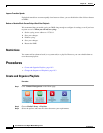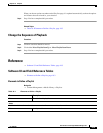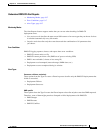
19-2
User Guide for Cisco Digital Media Manager 5.4.x
OL-15762-05
Chapter 19 Content Distribution and Delivery
Concepts
Understand DMP Support for the CIFS Protocol
Common Internet File System (CIFS) is a network protocol for sharing files and for obtaining remote
access to those files.
A CIFS share is a mount point on a network attached storage device that supports the CIFS protocol.
When you choose WAAS as your content distribution method, Cisco Digital Signs instructs DMPs to use
the CIFS protocol and mount a network share, such as a Windows shared folder, that uses CIFS.
Related Topics
•
Configure DMM to Use ACNS, WAAS, or ECDS, page 19-17
•
Procedures, page 19-16
Choose a Content Delivery System to Use with DMPs
In media networks, it is sometimes necessary to distribute large files where bandwidth capacity is
moderately or severely constrained. The challenge of doing this successfully is that delivering HD or SD
video streams and deploying large assets often requires an average data transfer rate of greater than
6 million bits per second (Mbps, or megabits). Media networks can compound your need for bandwidth.
There is a practical maximum limit in any WAN for how much bandwidth each of its remote sites can
use, and a content delivery solution can help you to manage multicast file distribution efficiently to the
DMPs that operate at your remote sites. In this way, content delivery solutions can enhance the
scalability of your existing network infrastructure and adapt it for media deployments.
ACNS, WAAS, and ECDS
ACNS and ECDS are designed for efficient delivery of video and other media assets. Both ACNS and
ECDS rely on edge servers to apply their optimizations. Although that edge server is called a CE in
ACNS, the equivalent in ECDS is called an SE. While ACNS can act as an HTTP/HTTPS proxy and can
leverage WCCP for direct or dynamic proxy, ECDS uses DNS to redirect its clients to an appropriate
service engine.
WAAS provide benefits with a much larger variety of content and protocols, including HTTP, HTTPS,
CIFS, NFS, MAPI (Exchange), VDI, live video and even legacy protocols (via TFO, LZ and DRE).
However, WAAS has fewer features than ACNS or ECDS, leaving it less flexible in terms of video.
WAAS requires that accelerators be installed at both the client side and the server side. With WAAS,
traffic optimization is completely transparent at both ends.
While ACNS and ECDS help with traffic-to-client traffic exclusively, WAAS optimizes traffic in both
directions and even among multiple branch offices.


















